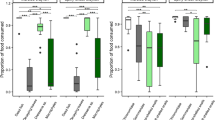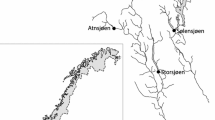Abstract
The introduced North-American signal crayfish (Pacifastacus leniusculus) has become widespread throughout Europe where it has often replaced the native noble crayfish (Astacus astacus). The impact of this replacement on ecosystem processes in boreal lakes is still largely unknown. We compared the trophic niches of these two crayfish species in 16 small to medium sized boreal lakes in southern Finland; eight lakes with noble crayfish and eight lakes where the native crayfish populations had been lost and replaced by signal crayfish. We analysed carbon and nitrogen stable isotopes from samples of the crayfish and their putative food sources, and used stable isotope models to compare trophic niche widths of the two species of crayfish and to quantify the food sources used by them. At species level the signal crayfish exhibited a substantially larger trophic niche than that of the noble crayfish, but within-lake populations of the species did not differ in their niche widths. The isotopic niches of the two species strongly overlapped, and while the estimated proportions of food resources (profundal and littoral macroinvertebrates, terrestrial leaf detritus and macrophytes) used by crayfish varied considerably among individual populations, they did not differ consistently between the species. Our results suggest that, contrary to often expressed concerns, replacement of lost noble crayfish populations by the signal crayfish may not greatly alter the littoral food web structure in boreal lakes.




Similar content being viewed by others
References
Aberle N, Hillebrand H, Grey J, Wiltshire KH (2005) Selectivity and competitive interactions between two benthic invertebrate grazers (Asselus aquaticus and Potamopyrgus antipodarum): an experimental study using 13C and 15N-labelled diatoms. Freshw Biol 50:369–379
Allan JD (1995) Stream ecology: structure and function of running waters. Chapman and Hall, London
Almeida D, Argent R, Ellis A, England J, Copp GH (2013a) Environmental biology of an invasive population of signal crayfish in the River Stort catchment (southeastern England). Limnologica 43:177–184
Almeida D, Ellis A, England J, Copp GH (2013b) Time-series analysis of native and non-native crayfish dynamics in the Thames River Basin (south-eastern England). Aquat Conserv Mar Freshw Ecosyst. doi:10.1002/aqc.2366
Anderson C, Cabana G (2007) Estimating the trophic position of aquatic consumers in river food webs using stable nitrogen isotopes. J N Am Benthol Soc 26:273–285
Arakelova KS (2001) The evaluation of individual production and scope for growth in aquatic sow bugs (Asellus aquaticus). Aquat Ecol 35:31–42
Barrientos R, Merino-Aguirre R, Fletcher DH, Almeida D (2013) Eurasian otter modify their trophic niche after the introduction of non-native prey in Mediterranean fresh waters. Biol Invasions. doi:10.1007/s10530-013-0622-9
Beatty SJ (2006) The diet and trophic positions of translocated, sympatric populatios of Cherax destructor and Cherax cainii in the Hutt River, Western Australia: evidence of resource overlap. Mar Freshw Res 57:825–835
Belovsky GE, Botkin DB, Crowl TA, Cummins KV, Franklin JF, Hunter ML, Joern A, Lindenmayer DB, MacMahon JA, Margules CR, Scott M (2004) Ten suggestions to strengthen the science of ecology. BioScience 54:345–351
Bubb DH, Thom TJ, Lucas MC (2006) Movement, dispersal and refuge use of co-occuring introduced and native crayfish. Freshw Biol 51:1359–1361
Cabana G, Rasmussen JB (1996) Comparison of aquatic food chains using nitrogen isotopes. Proc Natl Acad Sci USA 93:10844–10847
Carpenter SR (1996) Microcosm experiments have limited relevance for community and ecosystem ecology. Ecology 77:677–680
Diéguez UJ, Cerenius L, Dykova I, Gelder SR, Hentonen P, Jiravanichpaisal P, Lom J, Söderhäll K (2006) Pathogens, parasites and ectocommensals. In: Souty-Grosset C, Holdich DM, Noël PY, Reynolds JD, Haffner P (eds) Atlas of European crayfish distribution and diseases. Collection Patrimoines Naturels, vol 64. Muse’um National d’Histoire Naturelle, Paris, pp 133–155
Dorn NJ, Wojdak JM (2004) The role of omnivorous crayfish in littoral communities. Oecologia 140:150–159
Dudgeon D, Arhington AH, Gessner MO et al (2006) Freshwater biodiversity: importance, threats, status, and conservation challenges. Biol Rev 81:163–182
Erkamo E, Ruokonen TJ, Alapassi T, Ruokalainen J, Järvenpää T, Tulonen J, Kirjavainen J (2010) Evaluation of crayfish stocking success in Finland. Freshw Crayf 17:77–83
Hanshew BA, Tiffany SG (2012) Invasion of the shelter snatchers: behavioural plasticity in invasive red swamp crayfish, Proclambarus clarkii. Freshw Biol 57:2285–2296
Holdich DM, Reynolds JD, Souty-Grosset C, Sibley PJ (2009) A review of the ever increasing threat to European crayfish from non-indigenous crayfish species. Knowl Manag Aquat Ecosyst 11:394–395
Hoper DU, Chapin FS, Ewel JJ, Hector A, Inchausti P, Lavorel S, Lawton JH, Lodge DM, Loreau M, Naeem S, Schmid B, Setälä H, Smstad AJ, Vandermeer J, Wardle DA (2005) Effects of biodiversity on ecosystem functioning: a consensus of current knowledge. Ecol Soc Am Ecol Monogr 75(1):3–35
Hudina S, Hock K (2012) Behavioural determinants of agonistic success in invasive crayfish. Behav Process 91:77–81
Jackson AL, Inger R, Parnell AC, Bearhop S (2011) Comparing isotopic niche widths among and within communities: SIBER—stable isotope Bayesian ellipses in R. J Anim Ecol 8:595–602
Jackson MC, Donohue I, Jackson AL, Britton JR, Harper DM, Grey J (2012) Population-level metrics of trophic structure based on stable isotopes and their application to invasion ecology. PLoS One 2:e31757
Jefferies RL (2000) Allochthonous inputs: integrating population changing and food web dynamics. Trends Ecol Evol 15:19–22
Johnson RK, Goedkoop W (2002) Littoral macroinvertebrate communities: spatial scale and ecological relationships. Freshw Biol 47:1840–1854
Johnston K, Robson BJ, Fairweather PG (2011) Trophic positions of omnivores are not always flexible: evidence from four species of freshwater crayfish. Austral Ecol 36:269–279
Kalff J (2003) Limnology: inland water ecosystems. Prentice Hall, Upper Saddle River
Kirjavainen J, Sipponen M (2004) Environmental benefit of different crayfish management strategies in Finland. Fish Manag Ecol 11:213–218
Layman CA, Quattrocchi JP, Peyer CM, Allgeier JE (2007) Niche width collapse in a resilient top predator following ecosystem fragmentation. Ecol Lett 10:937–944
Lewis SD (2002) Pacifastacus. In: Holdich DM (ed) Biology of freshwater crayfish. Blackwell Science, Oxford, pp 511–540
Light T (2003) Success and failure in a lotic crayfish invasion: the rules of hydrologic variability and habitat alteration. Freshw Biol 48:1886–1897
Ligth T (2005) Behavioural effects of invaders: alien crayfish and native sculpin in a California stream. Biol Invasions 7:353–367
Lodge DM, Hill AH (1994) Factors governing species composition, population size, and productivity of cool-water crayfishes. Nord J Freshw Res 69:111–136
Lodge DM, Stein RA, Brown KB, Covich AP, Brönmark C, Garvey JE, Klosiewski SP (1998) Predicting impact of freshwater exotic species on native biodiversity: challenges in spatial scaling. Aust J Ecol 23:53–67
Mack RN, Simberloff D, Lonsdale WM, Evans H, Clout M, Bazzaz FA (2000) Biotic invasions: causes, epidemiology, global consequences, and control. Ecol Appl 10:689–710
McCarthy JM, Hein CL, Olden JD, Vander Zanden JM (2006) Coupling long-term studies with meta-analysis to investigate impacts of non-native crayfish on zoobenthic communities. Freshw Biol 51:224–235
McCutchan JH Jr, Lewis WM, Kendal C, McGrath CC (2003) Variation in trophic shift for stable isotope ratios of carbon, nitrogen and suphur. Oikos 102:378–390
Momot WT (1995) Redefining the role of freshwater crayfish in aquatic ecosystems. Rev Fish Sci 3:33–63
Moyle PB, Light T (1996) Fish invasions in California: do abiotic factors determine success? Ecology 77:1666–1670
Nyström P, Brönmark C, Granéli W (1996) Patterns in benthic food webs: a role for omnivorous crayfish? Freshw Biol 36:631–646
Nyström P, Brönmark C, Granéli W (1999) Influence of an exotic and a native crayfish species on a littoral benthic community. Oikos 85:545–553
Nyström P, Svensson O, Lardner B, Brönmark C, Granéli W (2001) The influence of multiple introduced predators on a littoral pond community. Ecology 82:1023–1039
Nyström P, Stenroth P, Holmqvist N, Berglud O, Larsson P, Granéli W (2006) Crayfish in lakes and streams: individual and population responses to predation, productivity and substratum availability. Freshw Biol 51:2096–2113
Olsson K, Stenroth P, Nyström P, Granéli W (2009) Invasions and niche width: does niche width of an introduced crayfish differ from a native crayfish? Freshw Biol 54:1731–1740
Parkyn SM, Collier KJ, Hicks BJ (2001) New Zealand stream crayfish: functional omnivores but trophic predators? Freshw Biol 46:641–652
Parnell AC, Inger R, Bearhop S, Jackson AL (2010) Source partitioning using stable isotopes: coupling with too much variation. PLoS One 5:e9672
Petren K, Case T (1996) An experimental demonstration of exploitation competition in an ongoing invasion. Ecology 77:118–132
R Development Core Team (2012) R: a language and environment for statistical computing. R Foundation for Statistical Computing, Vienna. ISBN 3-900051-07-0. http://www.R-project.org
Roel MJ, Orth DJ (1993) Trophic basis of production of stream-dwelling smallmouth bass, rock bass, and flathead catfish in relation to invertebrate bait harvest. Trans Am Fish Soc 122:46–62
Rudnik D, Resh V (2005) Stable isotopes, mesocosms and gut analysis demonstrate trophic differences in two invasive decapod crustacean. Freshw Biol 50:1323–1336
Ruokonen TJ, Kiljunen M, Karjalainen J, Hämäläinen H (2012) Invasive crayfish increase habitat connectivity: a case study in a large boreal lake. KnowL Manag Aquat Ecosyst 407:08
Sala OE, Chapin FS, Armesto JJ et al (2000) Biodiversity: global biodiversity scenarios for the year 2100. Science 287:1770–1774
Shea K, Chesson P (2002) Community ecology theory as a framework for biological invasions. Trends Ecol Evol 17:170–176
Smith VJ, Söderhäll K (1986) Crayfish pathology: an overview. Freshw Crayf 6:199–211
Söderbäck B (1995) Replacement of the native crayfish Astacus astacus by the introduced species Pacifastacus leniusculus in a Swedish lake: possible causes and mechanisms. Freshw Biol 33:291–304
Stenroth P, Nyström P (2003) Exotic crayfish in a brown stream: effects on juvenile trout, invertebrates and algae. Freshw Biol 48:466–475
Stenroth P, Holmqvist N, Nyström P, Berglund O, Larsson P, Graneli W (2006) Stable isotopes as an indicator of diet in omnivorous crayfish (Pacifastacus leniusculus): the influence of tissue, sample treatment, and season. Can J Fish Aquat Sci 63:821–831
Stenroth P, Holmqvist N, Nyström P, Berglund O, Larsson P, Granéli W (2008) The influence of productivity and width of littoral zone on the trophic position of a large-bodied omnivore. Oecologia 156:681–690
Strayer DL (2010) Alien species in fresh waters: ecological effects, interactions with other stressors, and prospects for the future. Freshw Biol 55:152–174
Svanbäck R, Persson L (2004) Individual diet specialization, niche width and populations dynamic: implication for trophic polymorphisms. J Anim Ecol 73:973–982
Syväranta J, Lensu A, Marjomäki TJ, Oksanen S, Jones RI (2013) An empirical evaluation of the utility of convex hull and standard ellipse areas for assessing population niche widths from isotope data. PLoS One 8:e56094
Tolonen KT, Hämäläinen H, Holopainen IJ, Karjalainen J (2001) Influences of habitat type and environmental variables on littoral macroinvertebrate communities in a large lake system. Arch Hydrobiol 152:39–67
Usio N (2000) Effects of crayfish on leaf processing and invertebrates colonisation of leaves in a headwater stream: decoupling of trophic cascade. Oecologia 124:608–614
Vander Zanden MJ, Rasmussen JB (2001) Variation in delta N-15 and delta C-13 trophic fractionation: implication for aquatic food web studies. Limnol Oceanogr 46:2061–2066
Vander Zanden JM, Shuter BJ, Lester N, Rasmussen JB (1999) Patterns of food chain length in lakes: as stable isotope study. Am Nat 154:406–416
Westman K, Savolainen R, Julkunen M (2002) Replacement of the native crayfish Astacus astacus by the introduced species Pacifastacus leniusculus in a small, enclosed Finnish lake: a 30-years study. Ecography 25:53–73
Wetzel RG (2001) Limnology: lake and river ecosystems. Academic Press, London
Whitledge GW, Rabeni CF (1996) Diel and seasonal variation in the food habits of crayfishes in a Missouri Ozark stream. Freshw Crayf 11:159–169
Whitledge GW, Rabeni CF (1997) Energy sources and ecological role of crayfishes in an Ozark stream: insights from stable isotopes and gut analysis. Can J Fish Aquat Sci 54:2555–2563
Acknowledgments
We thank Kimmo Sivonen for his valuable field work assistance and Tuula Sinisalo for assistance in the stable isotope laboratory. We also thank Finnish Game and Fisheries Institute to have provided crayfish monitoring data in all studied lakes. This study was supported by the Maj and Tor Nessling Foundation, the Finnish Cultural Foundation.
Author information
Authors and Affiliations
Corresponding author
Electronic supplementary material
Below is the link to the electronic supplementary material.
Rights and permissions
About this article
Cite this article
Ercoli, F., Ruokonen, T.J., Hämäläinen, H. et al. Does the introduced signal crayfish occupy an equivalent trophic niche to the lost native noble crayfish in boreal lakes?. Biol Invasions 16, 2025–2036 (2014). https://doi.org/10.1007/s10530-014-0645-x
Received:
Accepted:
Published:
Issue Date:
DOI: https://doi.org/10.1007/s10530-014-0645-x




